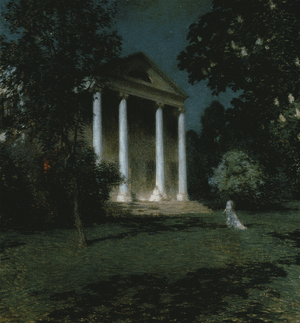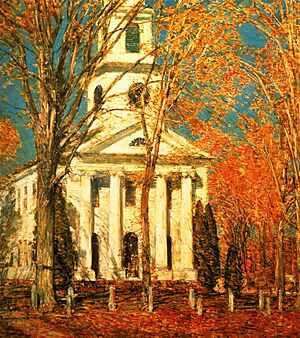Old Lyme art colony facts for kids
The Old Lyme art colony was a famous group of artists. It started in 1899 in Old Lyme, Connecticut. An American painter named Henry Ward Ranger created it. This art colony became the most well-known in the United States. It was also the first to embrace a painting style called Impressionism.
History of the Art Colony

Henry Ward Ranger wanted to create an art group like the French Barbizon school. This was a place where artists could escape city life. He started it in 1900 at the home of Florence Griswold. Other artists joined him, like Lewis Cohen and William Henry Howe. Later, a famous artist named Childe Hassam joined in 1903. He became a very important leader for the group.
The Old Lyme art colony was very important for American Impressionism. About 200 painters visited the colony over 30 years. Many famous Impressionist paintings show buildings in Old Lyme. For example, the Old Lyme Congregational Church was painted by Hassam and others. The 1906 painting May Night by Willard Metcalf shows the Florence Griswold House at night. People say the figure in the painting is Florence Griswold herself. This painting was the first modern artwork bought by the Corcoran Gallery of Art.
Old Lyme is still a lively art community today. The Florence Griswold House is now an art museum. It is called the Florence Griswold Museum, or "Flo Gris" by local people. The museum displays artworks and personal items from the artists who stayed there.
Artists of Old Lyme
Many artists were part of the Old Lyme art colony. Some of them include:
- Louis Betts
- Matilda Browne
- William Chadwick
- Bruce Crane
- Roger Wilson Dennis
- Frank DuMond
- Gladys Kelley Fitch
- Arthur Heming
- Harry Hoffman
- Wilson Irvine
- Allen Butler Talcott
- Edward Charles Volkert
- Guy C. Wiggins
- Bessie Potter Vonnoh
- Robert Vonnoh
See also
 In Spanish: Colonia artística de Old Lyme para niños
In Spanish: Colonia artística de Old Lyme para niños


